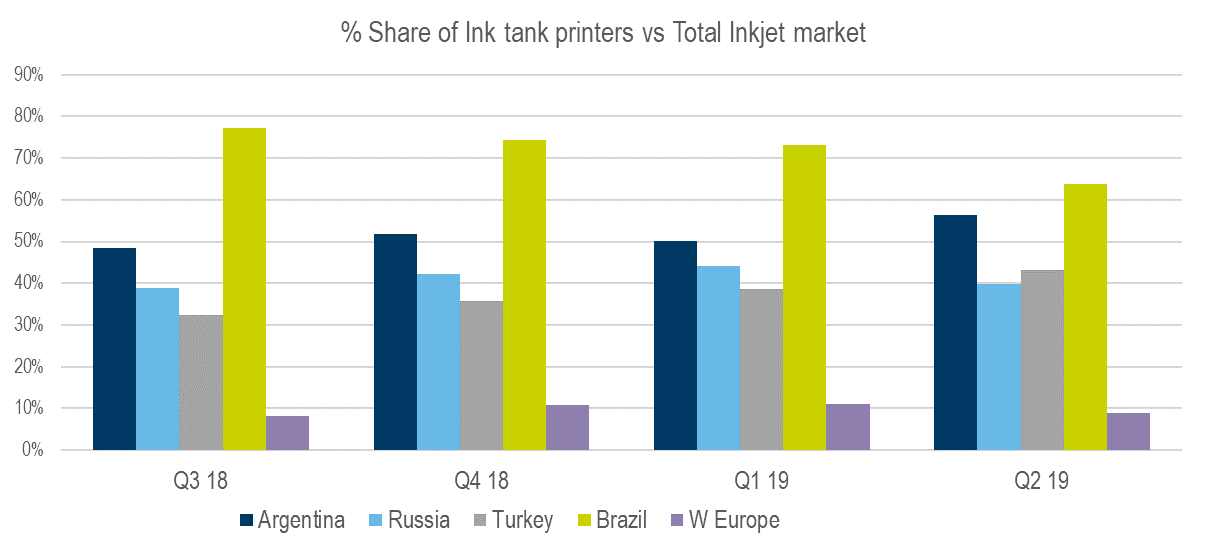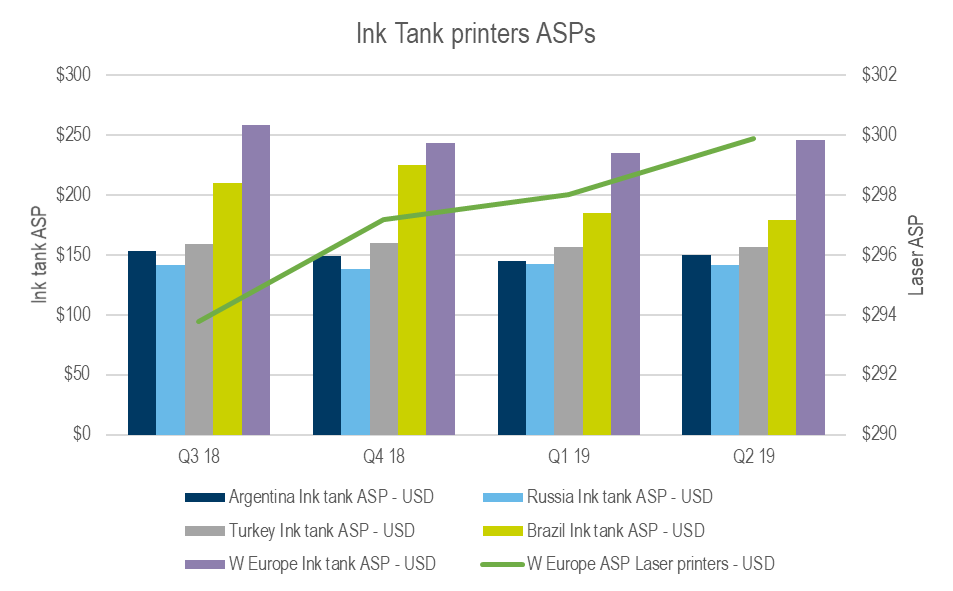The Rise of Ink Tank Printers
The rise of Ink Tank Printers in Emerging economies
Looking at the inkjet printing numbers in emerging countries (Argentina, Russia, Brazil & Turkey) there is a clear shift towards the lowest cost printing solutions available: ink tank printers. Emerging economies have suffered and lost considerable ground against the dollar throughout 2018 with very public struggles to maintain their currency afloat. This is especially obvious in the technology sector where prices have climbed significantly and consumer buying habits and behavior have pushed changes in the market as a result. The main printing vendors like HP, Epson & Canon have clearly understood these changes and have been steadily picking up sales in those countries via their ink tank printer offering the lowest cost per print for consumers. For roughly the same amount as buying 4 standard ink cartridges, a consumer can buy 4 ink bottles to fill up their ink tank printer. The big difference is that a full tank of ink will let you print anywhere from 6,000 to 8,000 black and white pages (4,000 to 6,000 color) while a standard set of ink cartridges will set you up to print anywhere between 400 to 600 pages (sometimes less). Let’s not hide the facts, ink tank printers are more expensive than standard inkjet printers however the huge difference in cost per print and profitability make the initial investment totally worthwhile.

In Q2 2019 the rise of ink tank printers sales in developing countries represents anywhere from 30% (Russia) to over 60% (Brazil) of the total inkjet printing market while it represents less than 10% of the total inkjet printing market in Western Europe. In fact, browsing through HP & Epson websites in Argentina & Brazil shows ink tank printer models dominate what’s on offer for consumers while doing the same in Western Europe shows limited availability and little marketing around this line of products. Epson and Canon each have a line of ink tank products available in Europe while HP stores in the UK and France show absolutely no ink tank printers. Given how these products have helped boost inkjet sales in emerging countries, it opens the question as to why this opportunity has not been exploited more in Western Europe.
A possible explanation may be pricing: the average selling price of ink tank printers in developing economies has come down significantly thanks to the volume of sales and competition between vendors but it seems still high in Western Europe in comparison as it averages $100 more than the ASPs of ink tank printers in Argentina, Russia, Brazil or Turkey. In fact, up until Q1 & Q2 2018, the ASP of ink tank printers in Western Europe was aligned with the ASP of laser printers, it has since come down but probably not enough to entice the customer to switch to ink tanks (as can be seen in this graph).

For once consumers in emerging countries are leading the way on this new technology adoption, even though the main driver, in this case, is cost. There is also a significant card to be played from printing vendors to market ink tank printers as eco-friendly (less plastic, reduced cost per print etc) which has not been sufficiently exploited and could be the best way to help European consumers see the huge potential in ink tank printing.
CONTEXT data shows there is a clear opportunity for printing vendors in the 800 million USD (2018) Western Europe inkjet market if they can generate enough momentum for a move away from standard ink cartridges and get consumers to buy into ink tank capabilities, but first prices have to come down.





I appreciate your information on ink tank printers. I found it interesting when you said that a full tank will print up to 8,000 black and white pages. I can see why business would like to buy a ink tank printer.